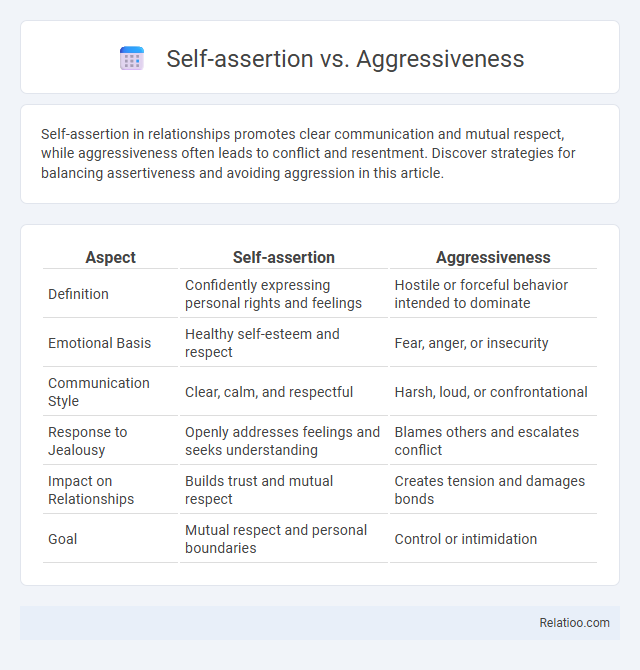Self-assertion in relationships promotes clear communication and mutual respect, while aggressiveness often leads to conflict and resentment. Discover strategies for balancing assertiveness and avoiding aggression in this article.
Table of Comparison
| Aspect | Self-assertion | Aggressiveness |
|---|---|---|
| Definition | Confidently expressing personal rights and feelings | Hostile or forceful behavior intended to dominate |
| Emotional Basis | Healthy self-esteem and respect | Fear, anger, or insecurity |
| Communication Style | Clear, calm, and respectful | Harsh, loud, or confrontational |
| Response to Jealousy | Openly addresses feelings and seeks understanding | Blames others and escalates conflict |
| Impact on Relationships | Builds trust and mutual respect | Creates tension and damages bonds |
| Goal | Mutual respect and personal boundaries | Control or intimidation |
Understanding Self-Assertion and Aggressiveness
Understanding self-assertion involves expressing your thoughts and feelings confidently while respecting others, which promotes healthy communication and personal boundaries. Aggressiveness, in contrast, often disregards others' rights and can lead to conflict or resentment. Balancing self-assertion allows you to stand up for yourself without crossing into aggressiveness, fostering mutual respect and effective interaction.
Key Differences Between Assertive and Aggressive Behavior
Assertive behavior involves expressing your thoughts and feelings clearly and respectfully, maintaining confidence without infringing on others' rights, while aggressive behavior disregards others' feelings and uses forceful, hostile communication. Key differences include tone, where assertiveness employs calm and firm language, and aggression uses loud or intimidating speech that can provoke conflict. Understanding these distinctions helps you communicate effectively and maintain healthy relationships without being overbearing or passive.
The Psychology Behind Self-Assertion
The psychology behind self-assertion involves expressing your thoughts and feelings confidently while respecting others' boundaries, promoting healthy interpersonal relationships. Unlike aggressiveness, which disregards others' rights and can provoke conflict, self-assertion enables clear communication without hostility. Understanding this distinction helps you develop effective social skills and enhances emotional intelligence for better personal and professional interactions.
Signs You Are Being Aggressive, Not Assertive
Signs you are being aggressive rather than assertive include interrupting others, speaking in a loud or hostile tone, and disregarding others' feelings or opinions. Aggressiveness often involves blaming, criticizing, or threatening, whereas assertiveness respects boundaries and promotes open, honest communication. Recognizing these behaviors helps maintain healthy interactions and assert personal needs without causing harm.
Benefits of Practicing Self-Assertion
Practicing self-assertion empowers you to confidently express your thoughts and needs while respecting others, fostering healthier relationships and effective communication. Unlike aggressiveness, which can damage connections and cause conflict, self-assertion promotes mutual understanding and conflict resolution. Consistent self-assertion enhances your self-esteem and decision-making abilities, leading to greater personal and professional success.
Negative Consequences of Aggressiveness
Aggressiveness often leads to damaged relationships due to its confrontational and hostile nature, causing others to feel threatened or disrespected. Unlike self-assertion, which promotes clear and respectful communication, aggressiveness can escalate conflicts and create a toxic environment. Persistent aggressive behavior increases stress levels and reduces collaboration, ultimately hindering personal and professional growth.
How to Develop Assertive Communication Skills
Developing assertive communication skills requires understanding the distinction between self-assertion and aggressiveness, where self-assertion involves expressing your thoughts and feelings confidently without violating others' rights, while aggressiveness disregards others' boundaries. Practice using clear, calm, and respectful language to communicate your needs effectively, maintaining eye contact and open body language to reinforce your message. Your ability to listen actively and respond empathetically will enhance mutual respect and improve interpersonal relationships.
Setting Boundaries Without Crossing the Line
Setting boundaries effectively requires balancing self-assertion and aggressiveness by clearly expressing your needs without infringing on others' rights. You establish respect for your personal limits through confident communication, ensuring your message is firm but not hostile. Mastering this balance prevents misunderstandings while promoting healthy relationships and mutual respect.
Navigating Conflict: Assertiveness Over Aggression
Navigating conflict effectively requires distinguishing self-assertion from aggressiveness, where self-assertion involves expressing needs and opinions confidently while respecting others' boundaries. Aggressiveness, in contrast, often leads to hostility and damages relationships by disregarding others' rights. Prioritizing assertiveness fosters constructive dialogue and conflict resolution, enhancing mutual understanding and collaboration.
Real-Life Scenarios: Applying Assertiveness Effectively
In real-life scenarios, self-assertion enables individuals to express their needs and boundaries clearly while respecting others, fostering productive communication and collaboration. Aggressiveness, in contrast, often leads to conflicts and damaged relationships due to its confrontational and disrespectful nature. Effectively applying assertiveness involves balancing confidence with empathy, using clear, non-threatening language to address issues constructively in personal and professional settings.

Infographic: Self-assertion vs Aggressiveness
 relatioo.com
relatioo.com